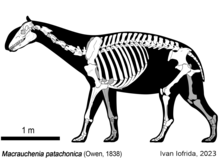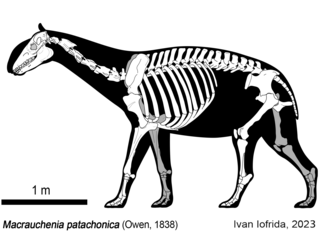
Litopterna is an extinct order of South American native ungulates that lived from the Paleocene to the end of the Pleistocene-early Holocene around 63 million-12,000 years ago, and were also present in Antarctica during the Eocene. They represent the second most diverse group of South American ungulates after Notoungulata. It is divided into nine families, with Proterotheriidae and Macraucheniidae being the most diverse and last surviving families.
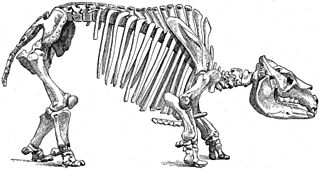
Notoungulata is an extinct order of mammalian ungulates that inhabited South America from the early Paleocene to the Holocene, living from approximately 61 million to 11,000 years ago. Notoungulates were morphologically diverse, with forms resembling animals as disparate as rabbits and rhinoceroses. Notoungulata are the largest group of South American native ungulates, with over 150 genera in 14 families having been described, divided into two major subgroupings, Typotheria and Toxodontia. Notoungulates first diversified during the Eocene. Their diversity declined from the late Neogene onwards, with only the large toxodontids persisting until the end of the Pleistocene, perishing as part of the Quaternary extinction event among with most other large mammals in the Americas. Collagen analysis suggests that notoungulates are closely related to litopterns, another group of South American ungulates, and their closest living relatives being perissodactyls, including rhinoceroses, tapirs and equines as part of the clade Panperissodactyla. However their relationships to other South American ungulates are uncertain. Several groups of notoungulates separately evolved ever-growing cheek teeth.

South American native ungulates, commonly abbreviated as SANUs, are extinct ungulate-like mammals of controversial affinities that were indigenous to South America prior to the Great American Biotic Interchange. They comprise five major groups conventionally ranked as orders—Astrapotheria, Litopterna, Notoungulata, Pyrotheria, and Xenungulata—as well as the primitive "condylarth" groups Didolodontidae and Kollpaniinae. It has been proposed that some or all of the members of this group form a clade, named Meridiungulata, though the relationships of South American ungulates remain largely unresolved. The two largest groups of South American ungulates, the notoungulates and the litopterns, were the only groups to persist beyond the mid Miocene. Only a few of the largest species of notoungulates and litopterns survived until the end-Pleistocene extinction event around 12,000 years ago where they became extinct with most other large mammals in the Americas, shortly after the first arrival of humans into the region.

Macrauchenia was a large, long-necked and long-limbed, three-toed native South American ungulate in the order Litopterna. The genus gives its name to its family, the Macraucheniidae or "robust litopterns". Like other litopterns, it is most closely related to the odd-toed ungulates (Perissodactyla), from which litopterns diverged approximately 66 million years ago. The oldest fossils in the genus date to the late Miocene, around seven million years ago, and M. patachonica disappears from the fossil record during the late Pleistocene, around 20,000-10,000 years ago. M. patachonica is one of the last and best known member of the family and is known primarily from the Luján Formation in Argentina, but is known from localities across southern South America. Another genus of macraucheniid Xenorhinotherium was present in northeast Brazil and Venezuela during the Late Pleistocene. The type specimen was discovered by Charles Darwin during the voyage of the Beagle. In life, Macrauchenia may have resembled a humpless camel, though the two taxa are not closely related. It fed on plants in a variety of environments across what is now South America. Among the species described, M. patachonica and M. ullomensis are considered valid; M. boliviensis is considered a nomen dubium; and M. antiqua has been moved to the genus Promacrauchenia.

Theosodon is an extinct genus of litoptern mammal from the Early to Middle Miocene of South America.
Huayqueriana is an extinct genus of South American litoptern, related to Macrauchenia, and belonging to the same family, Macraucheniidae. It was formerly known as Macrauchenidia latidens, described in 1939 by Cabrera, but redefined as Huayqueriana in 2016 based on the earlier name convention of Rovereto 1914. The genus is named after the Huayquerías Formation and the eponymous Huayquerian South American land mammal age defined at the formation.

Xenorhinotherium is an extinct genus of macraucheniine macraucheniids, closely related to Macrauchenia of Patagonia. The type species is X. bahiense.

Cramauchenia is an extinct genus of litoptern South American ungulate. Cramauchenia was named by Florentino Ameghino. The name has no literal translation. Instead, it is an anagram of the name of a related genus Macrauchenia. This genus was initially discovered in the Sarmiento Formation in the Chubut Province, in Argentina, and later it was found in the Chichinales Formation in the Río Negro Province and the Cerro Bandera Formation in Neuquén, also in Argentina, in sediments assigned to the SALMA Colhuehuapian, as well as the Agua de la Piedra Formation in Mendoza, in sediments dated to the Deseadan. In 1981 Soria made C. insolita a junior synonym of C. normalis. A specimen of C. normalis was described in 2010 from Cabeza Blanca in the Sarmiento Formation, in sediments assigned to the Deseadan SALMA.
Victorlemoinea is an extinct litoptern genus of the family Sparnotheriodontidae, that lived from the Early to Middle Eocene. Fossils of Victorlemoinea have been found in the Las Flores, Sarmiento and Koluel Kaike Formations of Argentina, the Itaboraí Formation of Brazil and La Meseta Formation, Antarctica.
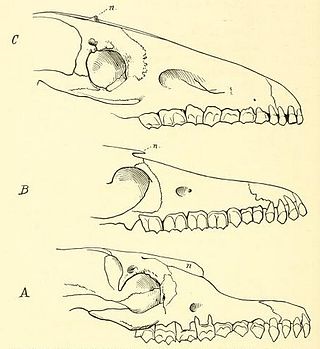
Scalabrinitherium is an extinct genus of mammals of the family Macraucheniidae. Fossils of this animal were found among the fossils of prehistoric xenarthrans in the Ituzaingó Formation of Argentina.

Astrapotheria is an extinct order of South American and Antarctic hoofed mammals that existed from the late Paleocene to the Middle Miocene, 59 to 11.8 million years ago. Astrapotheres were large, rhinoceros-like animals and have been called one of the most bizarre orders of mammals with an enigmatic evolutionary history.

Toxodontidae is an extinct family of notoungulate mammals, known from the Oligocene to the Holocene of South America, with one genus, Mixotoxodon, also known from the Pleistocene of Central America and southern North America. Member of the family were medium to large-sized, ranging from around 350–400 kilograms (770–880 lb) in Nesodon to 1,000–1,200 kilograms (2,200–2,600 lb) in Toxodon, and had medium to high-crowned dentition, which in derived members of the group evolved into ever-growing cheek teeth. Isotopic analyses have led to the conclusion that Pleistocene members of the family were flexible mixed feeders.

Proterotheriidae is an extinct family of litoptern ungulates known from the Oligocene-Late Pleistocene of South America. Members of the group were small-medium sized cursorial herbivores with brachydont teeth, with their toes showing progressive reduction, with later members of the group bearing weight on a single large toe similar to living horses.
Cullinia is an extinct genus of litoptern, an order of South American native ungulates that included horse-like and camel-like animals such as Macrauchenia. It is only known from fragmentary remains. Cullinia levis is known from Chasicoan remains found in the Arroyo Chasicó Formation of Argentina, and remains from the Brazilian state of Acre and the Huayquerian Ituzaingó Formation have been assigned to Cullinia sp..

Macraucheniinae is an extinct subfamily of macraucheniids that lived from the Late Miocene and potentially the Early Holocene, consisting of all the derived genera.
Promacrauchenia is an extinct genus of macraucheniids that lived during the Late Miocene to Late Pliocene epochs of what is now Argentina and Bolivia. It belongs to the subfamily Macraucheniinae, which also includes Huayqueriana, Macrauchenia, and Xenorhinotherium. Fossils of this genus have been found in the Ituzaingó, Andalhuala, and Cerro Azul Formations of Argentina.
Sparnotheriodontidae is an enigmatic extinct family of litopterns known primarily from teeth. Sparnotheriodontids are one of two South American native ungulate clades known to have reached Antarctica, the other being astrapotheres.
Polymorphis is an extinct genus of litopterns belonging to the family Macraucheniidae. It lived during the Middle Eocene of Argentina.
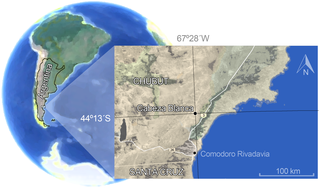
The Sarmiento Formation, in older literature described as the Casamayor Formation, is a geological formation in Chubut Province, Argentina, in central Patagonia, which spans around 30 million years from the mid-Eocene to the early Miocene. It predominantly consists of pyroclastic deposits, which were deposited in a semi-arid environment. It is divided up into a number of members. The diverse fauna of the Sarmiento Formation, including a variety of birds, crocodilians, turtles and snakes, also includes many mammals such as South American native ungulates as well as armadillos, and caviomorph rodents.
Pternoconius is an extinct genus of macraucheniid litoptern from the Late Oligocene and Early Miocene of Argentina. Fossils of this genus have been found in the Sarmiento Formation of Argentina.
